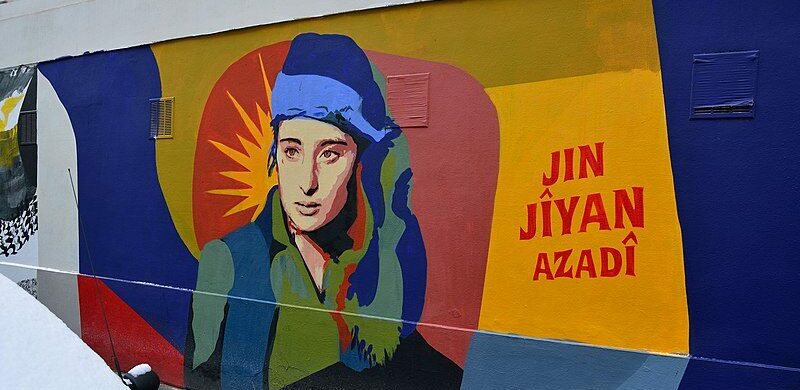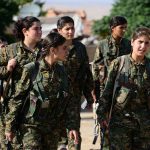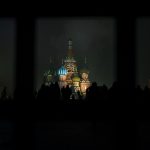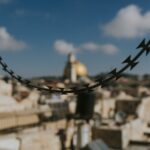Early morning, May 9, 2010. Five political prisoners at the Evin prison in Iran, four of them Kurdish, are executed by hanging for being “enemies of God”. Among the killed is one woman and activist of the Kurdish freedom movement, Sirin Alamhouli. The last time she leaves her cell, she leaves a message on the wall: Jin, jiyan, azadi. Woman, life, freedom. This is the first time the slogan is used in Iran.
Two years later, in the midst of the Syrian civil war, the Kurdish freedom movement proclaims the autonomy of the Kurdish areas in Syria. A feminist, democratic and socialist administration is established in Syrian Kurdistan, Rojava. The administration is forced to defend itself against many threats, among them Turkish and the Islamic State (IS) genocidal ambitions that threaten the very existence of the peoples of Rojava. The defense units of the administration, YPG, and the all-female YPJ prove to be a decisive force in crushing the IS.
When Raqqa, the de facto capital of the IS, fell after 135 days of heavy fighting in 2017, YPJ commander Nesrin Abdullah stands among the ruins with her soldiers and addresses the world. She proclaims that the liberation of the city shall be dedicated to all the women of the world. She ends her speech by saluting the soldiers with the motto: woman, life, freedom.
This slogan expresses the very essence of the Kurdish freedom movement. From the perspective of the architect and highest leader of the movement, Abdullah Öcalan, the freedom of women ranks higher than national self-determination. The movement argues that the patriarchal oppression of women, while certainly being unjustifiable in itself, is the root cause of a plethora of social problems because it serves as a model for other oppressive relationships. The Kurdish freedom movement does not understand the struggle against women’s oppression as a national or regional process. Instead, this struggle needs to extend into a global revolution against the patriarchal system.
From a spark comes fire
On September 16, 2022, 22-year-old Kurdish woman Jina Amini died in hospital three days after being severely assaulted by the morality police in Teheran. The morality police attacked Jina Amini because they thought she wore her hijab incorrectly. This sparked outrage across Iran and Iranian Kurdistan. People, especially women, took to the streets in huge protests where the hijab was burned and women cut off their hair.
The regime has withstood numerous protest movements in recent years. Declining living conditions is one contributing factor, 77 percent of young people are unemployed and inflation has skyrocketed after years of a deep recession. The political system lacks legitimacy in the eyes of a large proportion of the population. In the last election in 2021, the second most popular candidate was “invalid votes”. These factors contribute to recurrent cycles of political crisis, protest, and repression.
Women’s oppression is one of the main means through which the regime survives. The hijab is both a tool of oppression and a symbol of the regime’s power. Ever since the revolution in 1979 the regime has used the policing of female behavior, with the underlying threat of femicide, the systematic killing of women for being women as means for holding on to power. One of the many paradoxes of Iranian society is that women, while to a high degree being excluded from the workforce, dominate higher education as this is one of the few arenas where women are allowed to participate. This, as well as the general economic crisis, contributes to the reproduction of dissident cadres.
The spark that ignites the veil is thus a gesture of great political significance and potential. The motto “jin, jiyan, azadi” has been significant because it allows people of different backgrounds to unite around the shared experiences of women’s oppression. It allows for a kind of transversal politics, that is, a politics of uniting around shared problems despite being separated by different identities.
An important facet of the protest movement is that it expresses the fight of ethnic minorities – the Kurdish people, but also the Azeri and the Balochi peoples – for rights in Iran. The protests have been a means for these oppressed minorities to join hands with each other, as well as with Iranians, in the shared opposition to the Mullahs and the oppression of women.
Not a protest, revolution
The present social conflict in Iran is not only characterized by the wide support of the anti-regime movement, but it has also, despite ever more brutal attempts of quenching the movement, endured until today.
“This is not a movement, it is a revolution” is an oft-repeated slogan used by the movement. What makes a revolutionary situation? According to a classical definition by Vladimir Lenin, a revolutionary situation is characterized by three criteria: 1) the ruling classes cannot go on living the old way without change, leading to crisis and general discontent among the people, 2) the suffering and want of the people are more acutely felt than usually, 3) this leads to a great increase in the independent action of the masses.
The anti-regime movement in Iran does not demand concessions from the established order, it demands the fall of the regime. Politically advanced forces in the movement, such as the Kurdish freedom movement points both to the necessity of uniting around common objectives as well as to the movements’ readiness for armed struggle if necessary.
The hard-liners in the Iranian government refuse dialogue, but more and more representatives of the established order call for concessions. The economic crisis, the legitimacy crisis, the state of indecision among the ruling cliques and the enduring protests across the country all fulfill the criteria of a revolutionary situation. It is no longer a question of if the regime will fall, it is a question of when.
Johannes Malmgren
Johannes Malmgren holds a Master of Science in Media and Communication with specialization in political communication.





